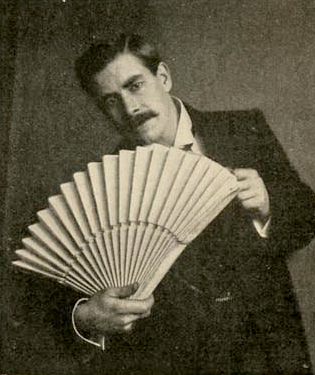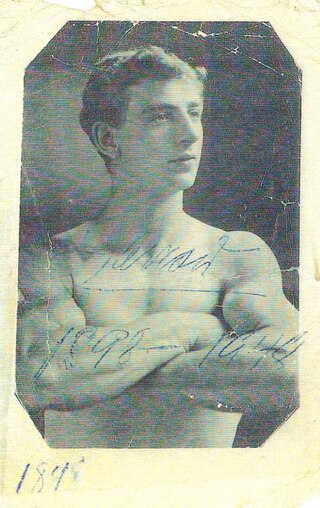Sources
- Hay, Harry. Cyclopedia of Magic (1949) ISBN 0-486-21808-2
| General | ||
|---|---|---|
| Genres | ||
| Tricks and techniques | ||
| Guidebooks |
| |
| Lists | ||
| Related | ||
The dove pan is a classic magic effect in which a magician produces a dove from an empty pan. The illusion continues to be performed by professional and amateur magicians.
In presentation, the magician demonstrates that the pan is empty and then fills it with a small quantity of a volatile liquid which is ignited. Often, the magician will place other items in the pan (e.g. cracking an egg into it) before setting the fuel on fire. To extinguish the fire, the magician slams the lid onto the pan. When the magician removes the lid, a dove flies from the pan which is shown to be otherwise empty.
The gimmick of the dove pan lies in the design of the lid. The deep shouldered rim of the lid conceals an additional pan (or liner) that fits snugly into the main pan. When the lid is placed on the pan the liner is deposited inside it, resembling the main pan when it was displayed empty. The liner, when fitted into the lid, may be loaded with birds (or anything else the magician wishes to produce) before the trick begins. The magician must not show the underside of the lid to the audience while performing the trick.
The effect consists of a shallow pan made of brass or aluminium and a matching lid which has a very deep rim or shoulder all around that fits inside the pan when closed. The pan is usually no more than ten inches in diameter and roughly 2-3 inches deep. Dove pans are a common item at magicians' supply stores.

David Blaine is an American magician, mentalist, and endurance performer. Born in New York City, Blaine became interested in magic at a very young age. He gained prominence in 1997, when his first television special, David Blaine: Street Magic, aired on ABC. That year, he also appeared in Magic Man. He later starred in the television specials David Blaine: Real or Magic (2013), Beyond Magic (2016), and The Magic Way (2020).

The Balducci levitation is a levitation illusion first described by Ed Balducci. Its inventor is unknown. It is an impromptu magic trick, which has been popularized by many magicians, such as David Roth, Paul Harris, and David Blaine.

A cartridge, also known as a round, is a type of pre-assembled firearm ammunition packaging a projectile, a propellant substance and an ignition device (primer) within a metallic, paper, or plastic case that is precisely made to fit within the barrel chamber of a breechloading gun, for convenient transportation and handling during shooting. Although in popular usage the term "bullet" is often used to refer to a complete cartridge, the correct usage only refers to the projectile.

The cups and balls is a performance of magic with innumerable adaptations. Street gambling variations performed by conmen were known as Bunco Booths. A typical cups and balls routine includes many of the most fundamental effects of magic: the balls can vanish, appear, transpose, reappear and transform. Basic skills, such as misdirection, manual dexterity, sleight of hand, and audience management are also essential to most cups and balls routines. As a result, mastery of the cups and balls is considered by many as the litmus test of a magician's skill with gimmick style tricks. Magician John Mulholland wrote that Harry Houdini had expressed the opinion that no one could be considered an accomplished magician until he had mastered the cups and balls. Professor Hoffman called the cups and balls "the groundwork of all legerdemain".

Ching Ling Foo was the stage name of the Chinese magician Chee Ling Qua. He is credited with being the first modern East Asian magician to achieve world fame.

Fred Kaps was a Dutch magician, famous for being the only magician to become FISM Grand Prix world champion three times. He was the creator of numerous original effects including his version of the color-changing silks. Another popular effect he often performed was the long-pour salt trick. Part of the act has Kaps exhibiting facial expressions of great surprise and disbelief, as he tries unsuccessfully to desperately stop the flow.

The bullet catch is a stage magic illusion in which a magician appears to catch a bullet fired directly at them — often in the mouth, sometimes in the hand or sometimes caught with other items such as a dinner plate. The bullet catch may also be referred to as the bullet trick, defying the bullets or occasionally the gun trick.

Billet reading, or the envelope trick, is a mentalist effect in which a performer pretends to use clairvoyance to read messages on folded papers or inside sealed envelopes. It is a widely performed "standard" of the mentalist craft since the middle of the 19th century. Billet is the French term for note or letter, referring to the rectangular shape of the paper.

Alexander Herrmann was a French magician, better known as Herrmann the Great. He was married to magician Adelaide Herrmann, known as the Queen of Magic.
The Zig-Zag Girl illusion is a stage illusion akin to the more famous sawing a woman in half illusion. In the Zig-Zag illusion, a magician divides an assistant into thirds, only to have them emerge from the illusion at the end of the performance completely unharmed.
This is a glossary of conjuring terms used by magicians.
Needle-through-arm is a magic illusion that was created by Bruce Spangler and later popularized by comedy actor/magician Harry Anderson. The trick can be performed as part of either a stage magic or a parlor magic routine. As the name would suggest, needle-through-arm relies on shock value to have a comedic effect.

David Devant was an English magician, shadowgraphist and film exhibitor. He was born David Wighton in Holloway, London. He is regarded by magicians as a consummate exponent of suave and witty presentation of stage illusion. According to magic historian Jim Steinmeyer, Devant was “England’s greatest magician—arguably the greatest magician of the 20th Century”.
The Guillotine is a magic trick where it appears that a blade of a guillotine passes through a person's neck without harming them. Variations on the theme have been performed for hundreds of years, with documented examples appearing in print in the 16th century. The most common modern variation is the finger guillotine or finger chopper, a pocked-sized version that appears to chop off the magician's finger.

Adelaide Herrmann (1853–1932) was an English magician and vaudeville performer billed as "the Queen of Magic." She was married to Alexander Herrmann, another magician.
Platform magic is magic that is done for larger audiences than close-up magic and for smaller audiences than stage magic. It is more intimate than stage magic because it does not require expensive, large-scale stage equipment and can thus be performed closer to the audience and without a stage. Many of the tricks performed by platform magicians are sufficiently angle-sensitive as to make them impossible to perform as micromagic. Most working magicians are parlor/platform magicians.

Magic, which encompasses the subgenres of illusion, stage magic, and close-up magic, among others, is a performing art in which audiences are entertained by tricks, effects, or illusions of seemingly impossible feats, using natural means. It is to be distinguished from paranormal magic which are effects claimed to be created through supernatural means. It is one of the oldest performing arts in the world.

Emil Jarrow was a sleight of hand magician. He sometimes referred to himself humorously as a "prestidigitator." Jarrow was perhaps best known for creating the “lemon trick,” in which he would procure paper money from an apparently fresh lemon.

A levitation illusion is one in which a magician appears to defy gravity by making an object or person float in the air. The subject may appear to levitate unassisted, or it may be performed with the aid of another object in which case it is termed a "suspension".